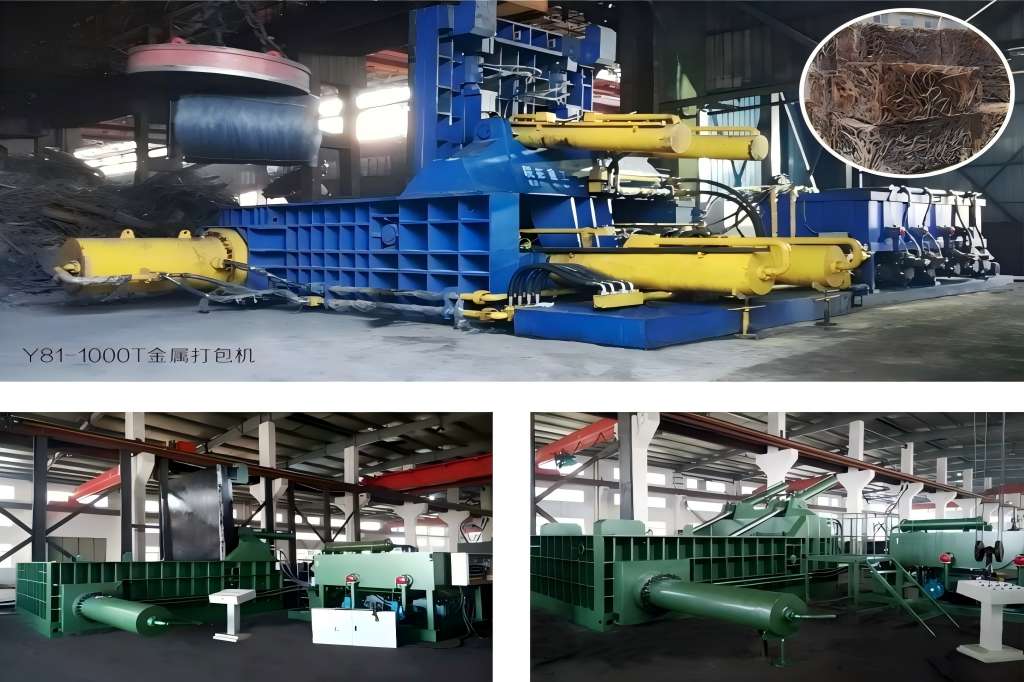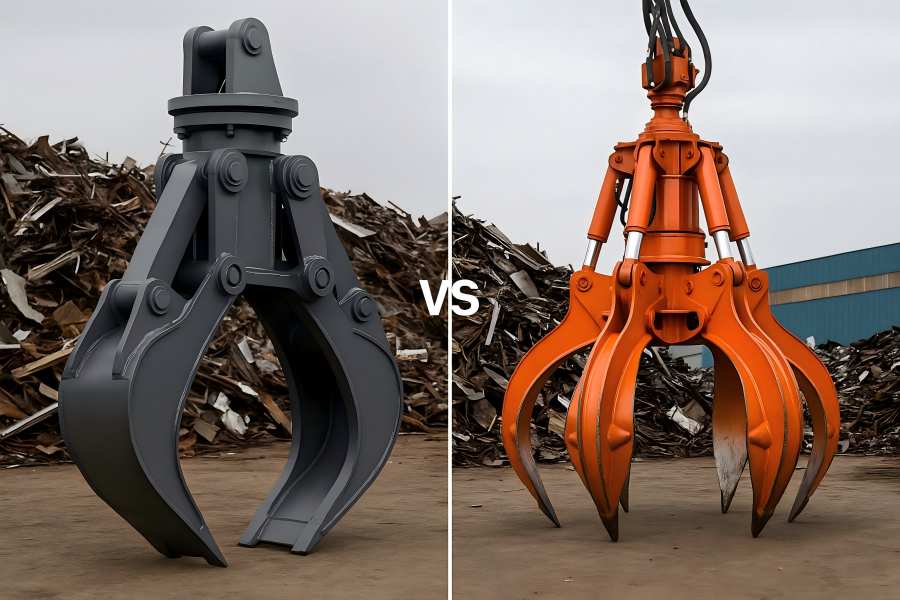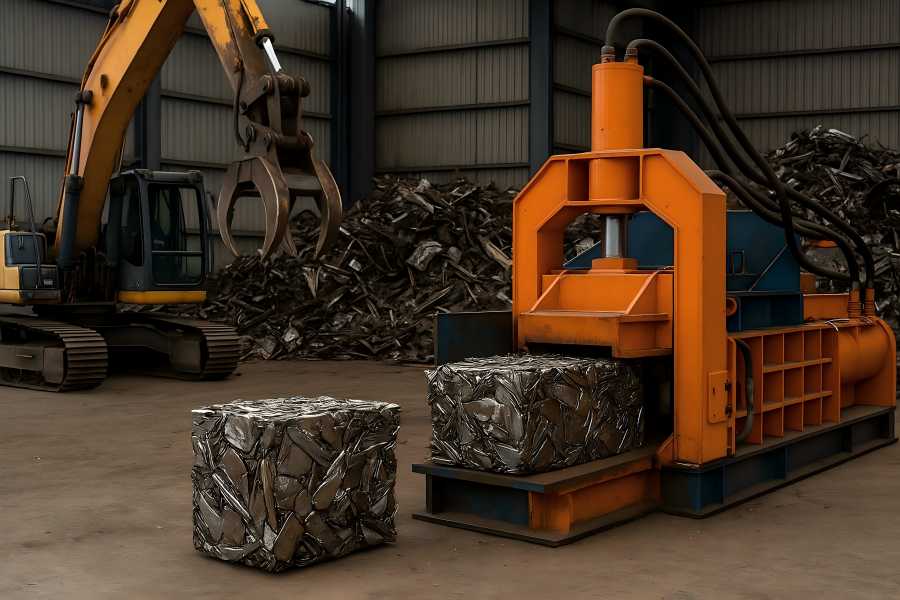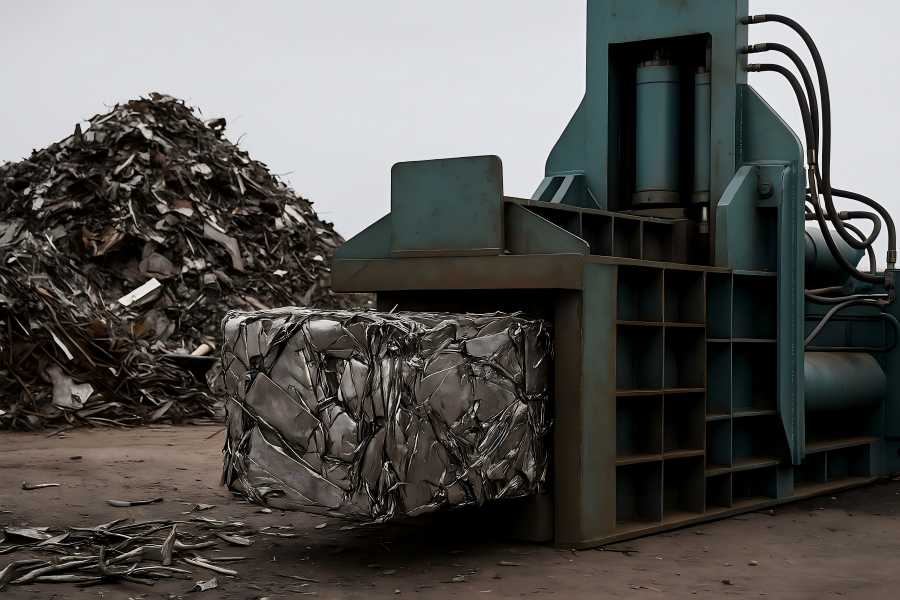Balers for scrap metal are essential for compacting stray metal into manageable, portable bales. As metal demand grows and regulations tighten, recycling plants must be efficient and minimize waste. Choosing the right baler is a smart, long-term move that boosts output, scrap value, transport efficiency, safety, and compliance.
A poor choice can lead to breakdowns, low-quality bales, and high energy costs, reducing profits. A suitable baler matches your scrap type and volume, improving efficiency and saving money. From small recyclers to large yards, the right baler helps drive overall success.
Types of Scrap Metal Balers and Their Applications

Scrap metal balers come in various types, each tailored to different material types, space availability, and automation needs. Understanding these types is fundamental to narrowing down the right solution for your operation:
a. Vertical Balers
Often used in smaller operations, vertical balers compact metal from top to bottom. These machines are cost-effective and space-efficient but typically suited for low-to-medium volumes.
b. Horizontal Balers
Ideal for high-throughput environments, horizontal balers process metal from side to side. They are frequently found at sizable recycling plants and scrap yards and can be either fully or semi-automatic.
c. Two-Ram Balers
Known for versatility, two-ram balers use one ram for compressing and another for ejecting. These machines handle a variety of metals and produce uniform, high-density bales, making them suitable for diverse recycling operations.
d. Mobile Balers
Designed for mobility, these balers can be moved to various job sites. They’re perfect for on-site scrap processing and demolition sites, offering both convenience and operational flexibility.
e. Logger Balers
Combining baling and shearing, logger balers are ideal for processing large, bulky scrap like car bodies or structural steel. They’re commonly used in automotive recycling and heavy metal recovery.
Processing Capacity: Matching Baler Output to Scrap Volume
Capacity is one of the most critical parameters when selecting a baler. Processing capacity is typically measured in tons per hour or bales per shift. Underestimating capacity leads to operational bottlenecks and downtime, while overestimating can result in excessive energy consumption and higher upfront costs.
To assess your capacity needs:
- Calculate the average scrap metal volume processed daily.
- Factor in future growth or increased production demand.
- Consider shifts per day and hours of operation.
- Identify peak and average throughput needs.
Matching machine throughput with facility scrap load ensures smooth operations, maximized uptime, and balanced workload across shifts.
Compression Force and Bale Density
Compression force, often measured in tons or kilonewtons (kN), directly impacts the density of the resulting bale. Bales with higher force are more compact and easier to move and store. This reduces shipping frequency and maximizes container capacity.
Typical compression forces range from 30 to over 200 tons, depending on baler type and scrap metal. For heavy, high-value metals like copper or stainless steel, high compression is crucial for maximizing material recovery and resale value.
Low-density bales may be rejected by mills or recyclers, forcing reprocessing or lower sale prices. Therefore, compression force is a critical consideration not only for operational effectiveness but also for final product quality and marketability.
Material Compatibility and Versatility
Not all balers handle all materials equally. Some are designed specifically for ferrous metals like steel and iron, while others can also process non-ferrous metals such as aluminum, copper, brass, and zinc. For facilities that deal with a wide range of materials, versatility becomes a must-have feature.
Features supporting versatility include:
- Adjustable chamber size
- Interchangeable cutting knives
- Programmable compression cycles
- Dual-ram capabilities
A baler that can seamlessly switch between different metals without reconfiguration saves time, reduces maintenance needs, and boosts productivity. Always review the machine’s metal handling capabilities and confirm with the supplier about your specific scrap mix.
Feeding and Loading Mechanisms
Feeding method influences labor requirements and cycle efficiency. Depending on the scale of your operation, you may require:
- Manual Loading: Suitable for small volumes and infrequent operation. Typically applies to vertical or small horizontal balers.
- Conveyor Feed: Best for continuous or high-volume operations. Scrap is automatically conveyed into the chamber, reducing downtime.
- Hopper Feed: Allows bulk loading of scrap into a wide opening. Often paired with hydraulic lids or pre-compression rams.
- Crane or Grapple Feed: Used in heavy-duty balers like logger balers and mobile balers.
The chosen loading method should align with your workforce availability, space, and type of scrap material. Efficient loading minimizes cycle time and reduces operator fatigue.
Bale Ejection System and Automation Level
Ejection systems remove the finished bale from the compression chamber and can be:
- Manual: Requires operator intervention, usually via a chain or lever system.
- Semi-Automatic: Involves button-activated ejection, but still needs some manual handling.
- Fully Automatic: Uses hydraulic pushers or ejectors, requiring no manual handling.
For high-volume operations, fully automated ejection is recommended to maintain output speed and minimize physical strain on operators.
In tandem with ejection is the automation level of the baler:
- Manual Balers: Low cost, but labor-intensive.
- Semi-Automatic Balers: Blend manual loading or tying with automated pressing and ejection.
- Fully Automatic Balers: Handle the entire cycle, including feeding, compressing, tying, and ejecting, ideal for continuous operations.
Machine Footprint and Installation Requirements
Balers vary significantly in size. A two-ram horizontal baler may require several square meters of floor space, plus room for maintenance and loading. On the other hand, mobile or vertical balers can be installed in compact facilities with limited space.
Installation factors to consider:
- Available floor space and height clearance
- Weight-bearing capacity of floors
- Electrical and hydraulic connections
- Ventilation and heat dissipation
- Foundations or mounting requirements
Some manufacturers offer custom configurations or space-saving designs to accommodate tight layouts. Always review floor plans and conduct site surveys before finalizing equipment selection.
Safety Features and Operator Controls
Safety is non-negotiable in metal processing environments. Modern balers are equipped with safety systems to protect personnel and equipment. Look for features such as:
- Emergency stop buttons
- Interlocked doors or guards
- Two-hand operation controls
- Overload and pressure sensors
- Lockout/tagout compatibility
- CE or UL safety certification
In addition to hardware, the software interface also plays a role. Advanced Human-Machine Interfaces (HMIs) with touchscreens allow operators to monitor system diagnostics, view cycle status, and receive error alerts in real time. A safe baler is not only ethical—it also minimizes downtime and insurance liabilities.
Maintenance Access and Build Quality
Durability defines long-term cost efficiency. A baler made of reinforced steel, with wear-resistant components like hardened knives and chromium-plated cylinders, will outperform cheaper models in the long run.
Equally important is ease of maintenance:
- Wide-access doors or removable panels
- Centralized lubrication points
- Quick-disconnect hydraulic lines
- Diagnostic tools or onboard maintenance alerts
Preventive maintenance schedules and easy access reduce unplanned downtime and extend machine lifespan. Choose a baler with a reputation for low maintenance frequency and accessible parts.
Power Source and Energy Consumption
Most scrap balers are powered by electric motors, typically ranging from 15 kW to over 100 kW depending on size. For use in isolated or outdoor settings, certain mobile or portable variants are diesel-powered.
Energy efficiency is essential, particularly for businesses looking to save power costs and reduce their impact on the environment.
Features that improve energy performance include:
- Variable frequency drives (VFDs)
- Programmable logic controllers (PLCs)
- Idle shutdown timers
- Hydraulic system optimization
High-efficiency systems consume less power per ton of scrap processed, helping meet ESG targets and reducing operational overhead.
Customization Options and Future Scalability
No two operations are the same. A manufacturer that offers customization ensures your baler aligns with your production line, scrap mix, and future upgrades.
Customization options may include:
- Chamber size
- Feed opening dimensions
- Pressure rating
- Tie systems (manual, wire, strap)
- Bale wrapping or labeling systems
- Integration with shredders, conveyors, or sorters
If your scrap volume is expected to grow, select a baler that can scale with your operations, either through modular add-ons or higher throughput configurations.
Vendor Reputation and After-Sales Support
The baler itself is only part of the investment—after-sales support is equally important. Choose vendors with:
- Proven track records and customer references
- Global or regional service networks
- Readily available spare parts
- On-site training and commissioning
- Remote diagnostics and technical assistance
A vendor who understands your industry can provide insight, guidance, and fast resolutions to issues. Partnering with a reputable brand minimizes business disruption and maximizes machine uptime.
Cost, Financing, and Return on Investment
Baler prices range widely—from $10,000 for a basic vertical baler to over $500,000 for high-capacity, fully automatic horizontal or two-ram units. However, cost should be evaluated alongside:
- Lifetime operating costs
- Scrap resale value
- Downtime reduction
- Labor savings
- Energy efficiency
Financing options, such as leasing or installment payments, may make high-end models more accessible. Many balers use higher income and operational savings to pay for themselves in 12 to 36 months.
When calculating ROI, also include intangible benefits such as improved workplace safety, reduced scrap handling time, and better environmental compliance.




